air condition Peugeot 407 C Dag 2008 Owner's Guide
[x] Cancel search | Manufacturer: PEUGEOT, Model Year: 2008, Model line: 407 C Dag, Model: Peugeot 407 C Dag 2008Pages: 211, PDF Size: 11.75 MB
Page 131 of 211
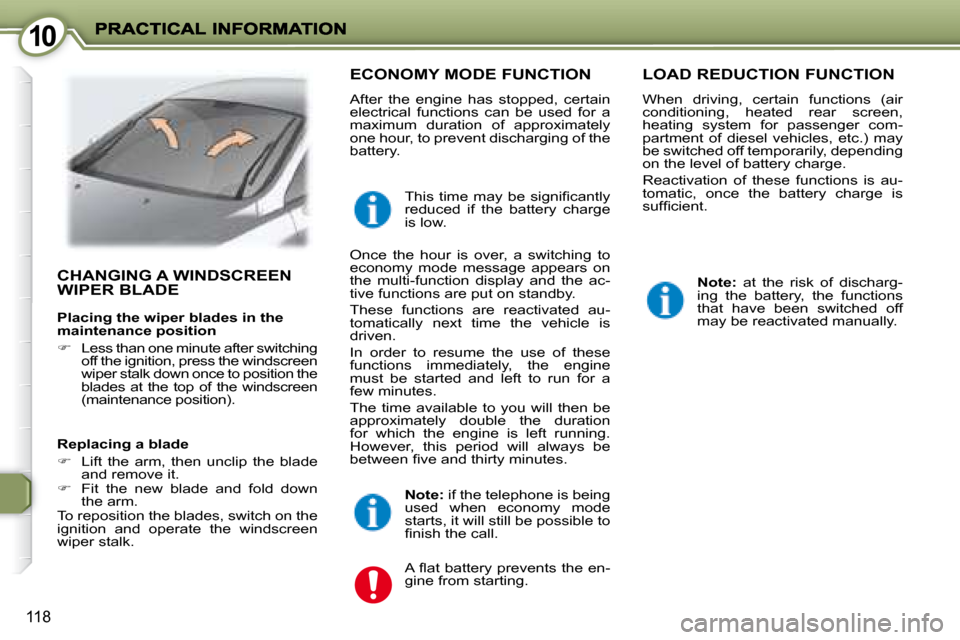
1010
118
CHANGING A WINDSCREEN WIPER BLADE
ECONOMY MODE FUNCTION
After the engine has stopped, certain
electrical functions can be used for a
maximum duration of approximately
one hour, to prevent discharging of the
battery.
LOAD REDUCTION FUNCTION
When driving, certain functions (air
conditioning, heated rear screen,
heating system for passenger com-
partment of diesel vehicles, etc.) may
be switched off temporarily, depending
on the level of battery charge.
Reactivation of these functions is au-
tomatic, once the battery charge is
�s�u�f�fi� �c�i�e�n�t�.�
Note: at the risk of discharg-
ing the battery, the functions
that have been switched off
may be reactivated manually.
Note: if the telephone is being
used when economy mode
starts, it will still be possible to
�fi� �n�i�s�h� �t�h�e� �c�a�l�l�.�
� �A� �fl� �a�t� �b�a�t�t�e�r�y� �p�r�e�v�e�n�t�s� �t�h�e� �e�n�-
gine from starting.
Replacing a blade
� Lift the arm, then unclip the blade
and remove it.
� Fit the new blade and fold down
the arm.
To reposition the blades, switch on the
ignition and operate the windscreen
wiper stalk. Once the hour is over, a switching to
economy mode message appears on
the multi-function display and the ac-
tive functions are put on standby.
These functions are reactivated au-
tomatically next time the vehicle is
driven.
In order to resume the use of these
functions immediately, the engine
must be started and left to run for a
few minutes.
The time available to you will then be
approximately double the duration
for which the engine is left running.
However, this period will always be
�b�e�t�w�e�e�n� �fi� �v�e� �a�n�d� �t�h�i�r�t�y� �m�i�n�u�t�e�s�.�
� �T�h�i�s� �t�i�m�e� �m�a�y� �b�e� �s�i�g�n�i�fi� �c�a�n�t�l�y�
reduced if the battery charge
is low.
Placing the wiper blades in the
maintenance position
� Less than one minute after switching
off the ignition, press the windscreen
wiper stalk down once to position the
blades at the top of the windscreen
(maintenance position).
Page 135 of 211
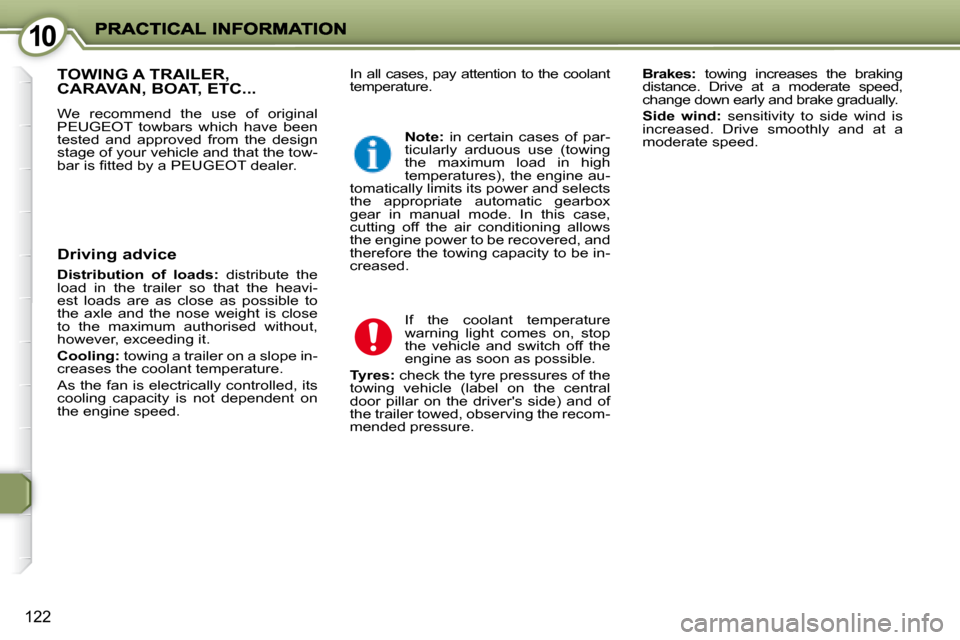
1010
122
In all cases, pay attention to the coolant
temperature.
Brakes: towing increases the braking
distance. Drive at a moderate speed,
change down early and brake gradually.
Side wind: sensitivity to side wind is
increased. Drive smoothly and at a
moderate speed. TOWING A TRAILER, CARAVAN, BOAT, ETC...
We recommend the use of original
PEUGEOT towbars which have been
tested and approved from the design
stage of your vehicle and that the tow-
�b�a�r� �i�s� �fi� �t�t�e�d� �b�y� �a� � �P�E�U�G�E�O�T� � �d�e�a�l�e�r�.�
Driving advice
Distribution of loads: distribute the
load in the trailer so that the heavi-
est loads are as close as possible to
the axle and the nose weight is close
to the maximum authorised without,
however, exceeding it.
Cooling: towing a trailer on a slope in-
creases the coolant temperature.
As the fan is electrically controlled, its
cooling capacity is not dependent on
the engine speed.
Note: in certain cases of par-
ticularly arduous use (towing
the maximum load in high
temperatures), the engine au-
tomatically limits its power and selects
the appropriate automatic gearbox
gear in manual mode. In this case,
cutting off the air conditioning allows
the engine power to be recovered, and
therefore the towing capacity to be in-
creased.
If the coolant temperature
warning light comes on, stop
the vehicle and switch off the
engine as soon as possible.
Tyres: check the tyre pressures of the
towing vehicle (label on the central
door pillar on the driver's side) and of
the trailer towed, observing the recom-
mended pressure.
Page 145 of 211
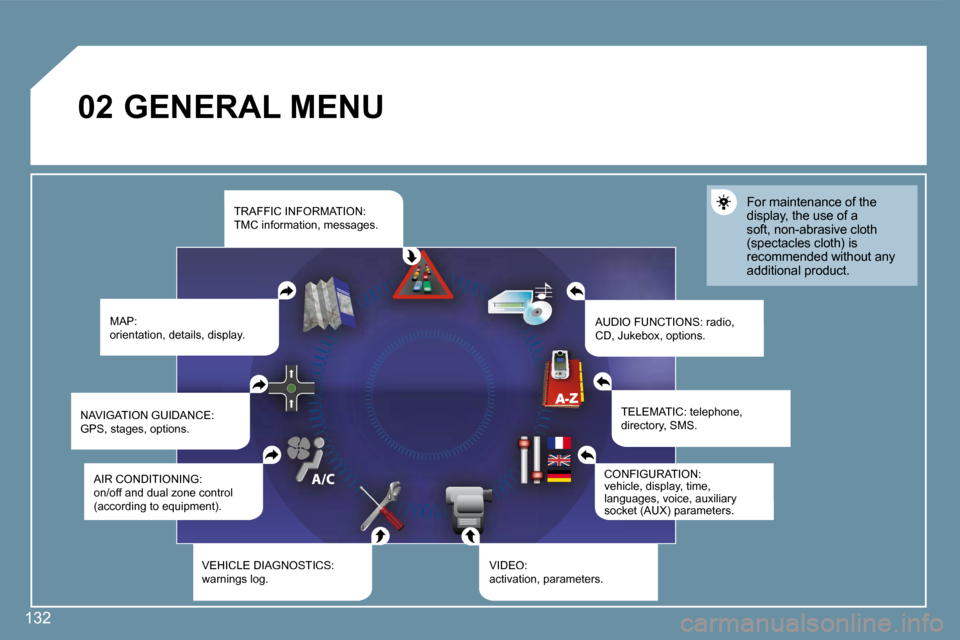
�0�2
132
� �G�E�N�E�R�A�L� �M�E�N�U�
MAP: orientation, details, display. AUDIO FUNCTIONS: radio, CD, Jukebox, options.
For maintenance of the display, the use of a soft, non-abrasive cloth �(�s�p�e�c�t�a�c�l�e�s� �c�l�o�t�h�)� �i�s� recommended without any additional product.
TELEMATIC: telephone, directory, SMS.
CONFIGURATION: vehicle, display, time, languages, voice, auxiliary �s�o�c�k�e�t� �(�A�U�X�)� �p�a�r�a�m�e�t�e�r�s�.�
VIDEO: activation, parameters. VEHICLE DIAGNOSTICS: warnings log.
AIR CONDITIONING: on/off and dual zone control �(�a�c�c�o�r�d�i�n�g� �t�o� �e�q�u�i�p�m�e�n�t�)�.�
NAVIGATION GUIDANCE:GPS, stages, options.
TRAFFIC INFORMATION: TMC information, messages.
Page 169 of 211
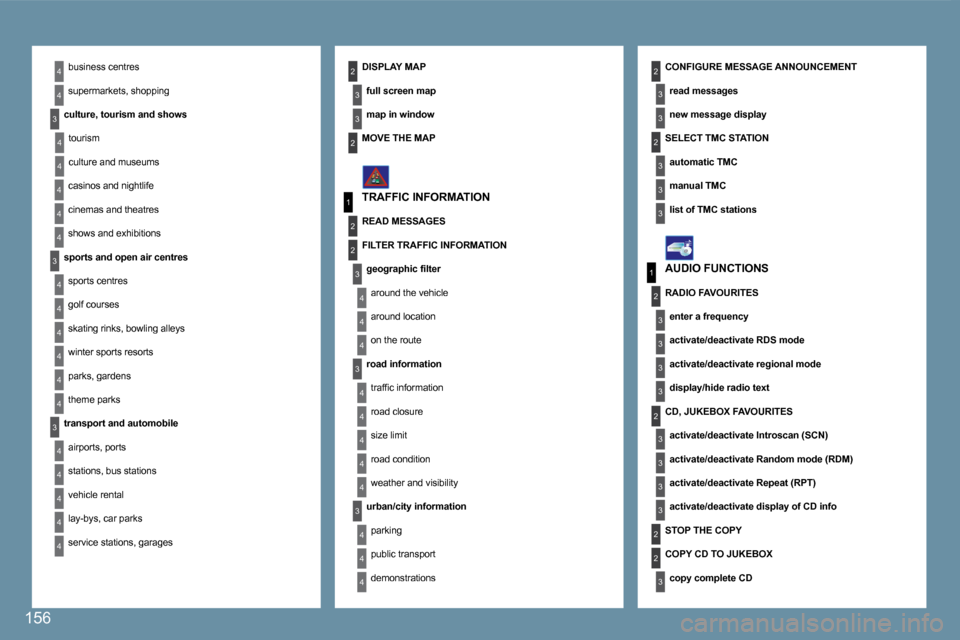
4
4
4
4
4
4
4
4
3
4
4
4
4
3
3
4
4
1
2
3
4
4
4
3
4
4
4
4
4
1
2
3
3
3
3
3
3
3
3
2
3
2
2
3
3
3
3
22
4
4
2
4
4
3
3
4
4
4
3
3
22
156
business centres
supermarkets, shopping
� � �c�u�l�t�u�r�e�,� �t�o�u�r�i�s�m� �a�n�d� �s�h�o�w�s� �
tourism
culture and museums
casinos and nightlife
cinemas and theatres
shows and exhibitions
� � �s�p�o�r�t�s� �a�n�d� �o�p�e�n� �a�i�r� �c�e�n�t�r�e�s� �
sports centres
golf courses
skating rinks, bowling alleys
winter sports resorts
parks, gardens
theme parks
� � �t�r�a�n�s�p�o�r�t� �a�n�d� �a�u�t�o�m�o�b�i�l�e� �
airports, ports
stations, bus stations
vehicle rental
lay-bys, car parks
service stations, garages
� � �D�I�S�P�L�A�Y� �M�A�P�
� � �f�u�l�l� �s�c�r�e�e�n� �m�a�p� �
� � �m�a�p� �i�n� �w�i�n�d�o�w� � �
� � �C�O�N�F�I�G�U�R�E� �M�E�S�S�A�G�E� �A�N�N�O�U�N�C�E�M�E�N�T�
� � �r�e�a�d� �m�e�s�s�a�g�e�s� �
� � �n�e�w� �m�e�s�s�a�g�e� �d�i�s�p�l�a�y� � �
� � �T�R�A�F�F�I�C� �I�N�F�O�R�M�A�T�I�O�N�
� � �A�U�D�I�O� �F�U�N�C�T�I�O�N�S�
� � �M�O�V�E� �T�H�E� �M�A�P� � �
� � �R�E�A�D� �M�E�S�S�A�G�E�S� �
� � �F�I�L�T�E�R� �T�R�A�F�F�I�C� �I�N�F�O�R�M�A�T�I�O�N�
� � �g�e�o�g�r�a�p�h�i�c� �fi� �l�t�e�r� �
around the vehicle
around location
on the route
� � �r�o�a�d� �i�n�f�o�r�m�a�t�i�o�n� �
� �t�r�a�f�fi� �c� �i�n�f�o�r�m�a�t�i�o�n�
road closure
size limit
road condition
weather and visibility
� � �u�r�b�a�n�/�c�i�t�y� �i�n�f�o�r�m�a�t�i�o�n� �
parking
public transport
demonstrations
� � �S�E�L�E�C�T� �T�M�C� �S�T�A�T�I�O�N�
� � �a�u�t�o�m�a�t�i�c� �T�M�C� �
� � �m�a�n�u�a�l� �T�M�C� �
� � �l�i�s�t� �o�f� �T�M�C� �s�t�a�t�i�o�n�s� � � �
� � �R�A�D�I�O� �F�A�V�O�U�R�I�T�E�S�
� � �e�n�t�e�r� �a� �f�r�e�q�u�e�n�c�y� �
� � �a�c�t�i�v�a�t�e�/�d�e�a�c�t�i�v�a�t�e� �R�D�S� �m�o�d�e� �
� � �a�c�t�i�v�a�t�e�/�d�e�a�c�t�i�v�a�t�e� �r�e�g�i�o�n�a�l� �m�o�d�e� �
� � �d�i�s�p�l�a�y�/�h�i�d�e� �r�a�d�i�o� �t�e�x�t� � �
� � �C�D�,� �J�U�K�E�B�O�X� �F�A�V�O�U�R�I�T�E�S�
� � �a�c�t�i�v�a�t�e�/�d�e�a�c�t�i�v�a�t�e� �I�n�t�r�o�s�c�a�n� �(�S�C�N�)� �
� � �a�c�t�i�v�a�t�e�/�d�e�a�c�t�i�v�a�t�e� �R�a�n�d�o�m� �m�o�d�e� �(�R�D�M�)� �
� � �a�c�t�i�v�a�t�e�/�d�e�a�c�t�i�v�a�t�e� �R�e�p�e�a�t� �(�R�P�T�)� �
� � �a�c�t�i�v�a�t�e�/�d�e�a�c�t�i�v�a�t�e� �d�i�s�p�l�a�y� �o�f� �C�D� �i�n�f�o� � �
� � �S�T�O�P� �T�H�E� �C�O�P�Y� �
� � �C�O�P�Y� �C�D� �T�O� �J�U�K�E�B�O�X�
�c�o�p�y� �c�o�m�p�l�e�t�e� �C�D
Page 176 of 211
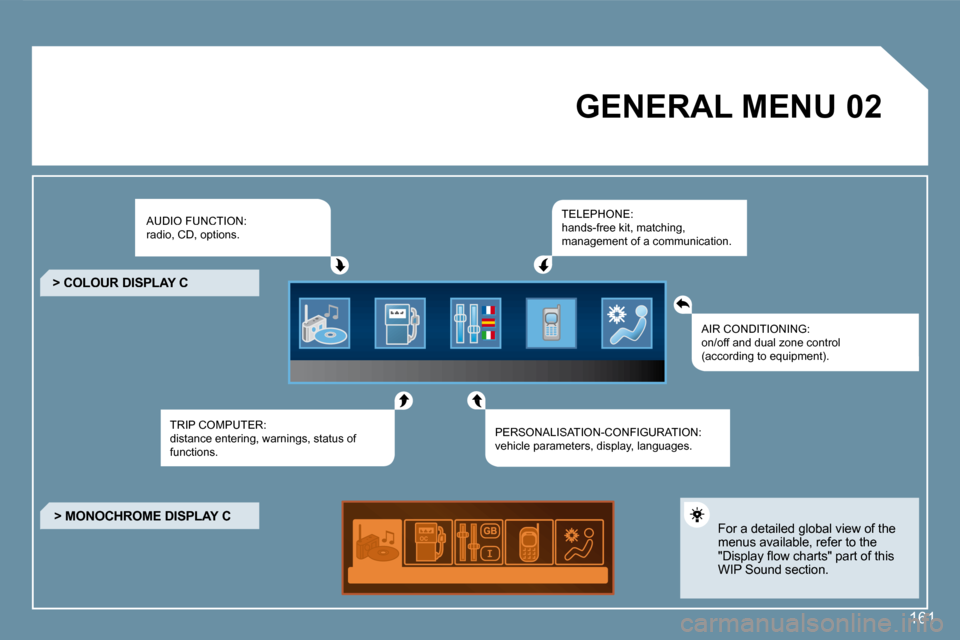
�0�2
161
� �G�E�N�E�R�A�L� �M�E�N�U�
AUDIO FUNCTION: radio, CD, options.
TRIP COMPUTER: distance entering, warnings, status of functions.
TELEPHONE: hands-free kit, matching, management of a communication.
PERSONALISATION-CONFIGURATION: vehicle parameters, display, languages.
� � �>� �C�O�L�O�U�R� �D�I�S�P�L�A�Y� �C�
� � �>� �M�O�N�O�C�H�R�O�M�E� �D�I�S�P�L�A�Y� �C�
AIR CONDITIONING: on/off and dual zone control �(�a�c�c�o�r�d�i�n�g� �t�o� �e�q�u�i�p�m�e�n�t�)�.�
For a detailed global view of the menus available, refer to the �"�D�i�s�p�l�a�y� �fl� �o�w� �c�h�a�r�t�s�"� �p�a�r�t� �o�f� �t�h�i�s� WIP Sound section.